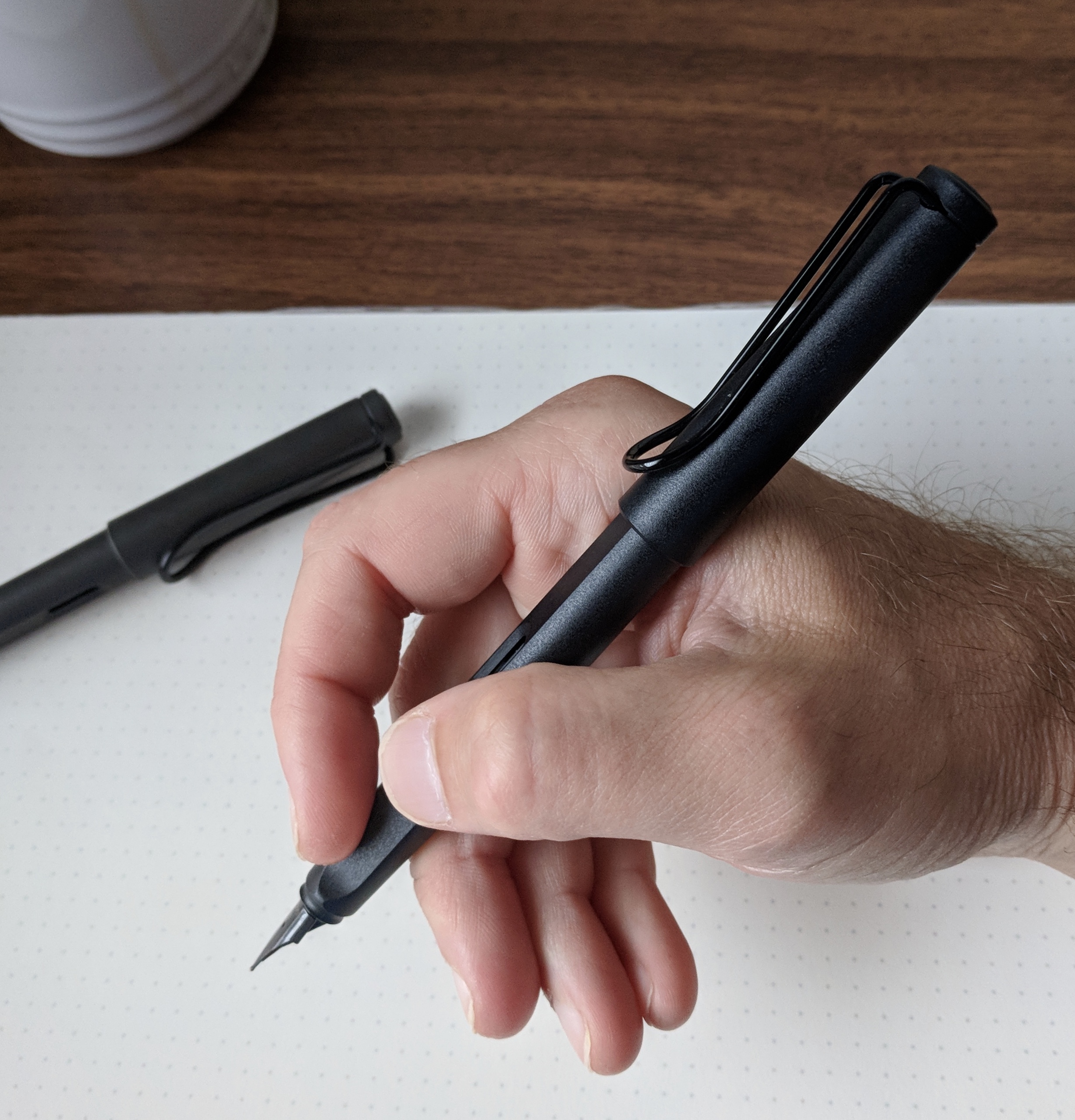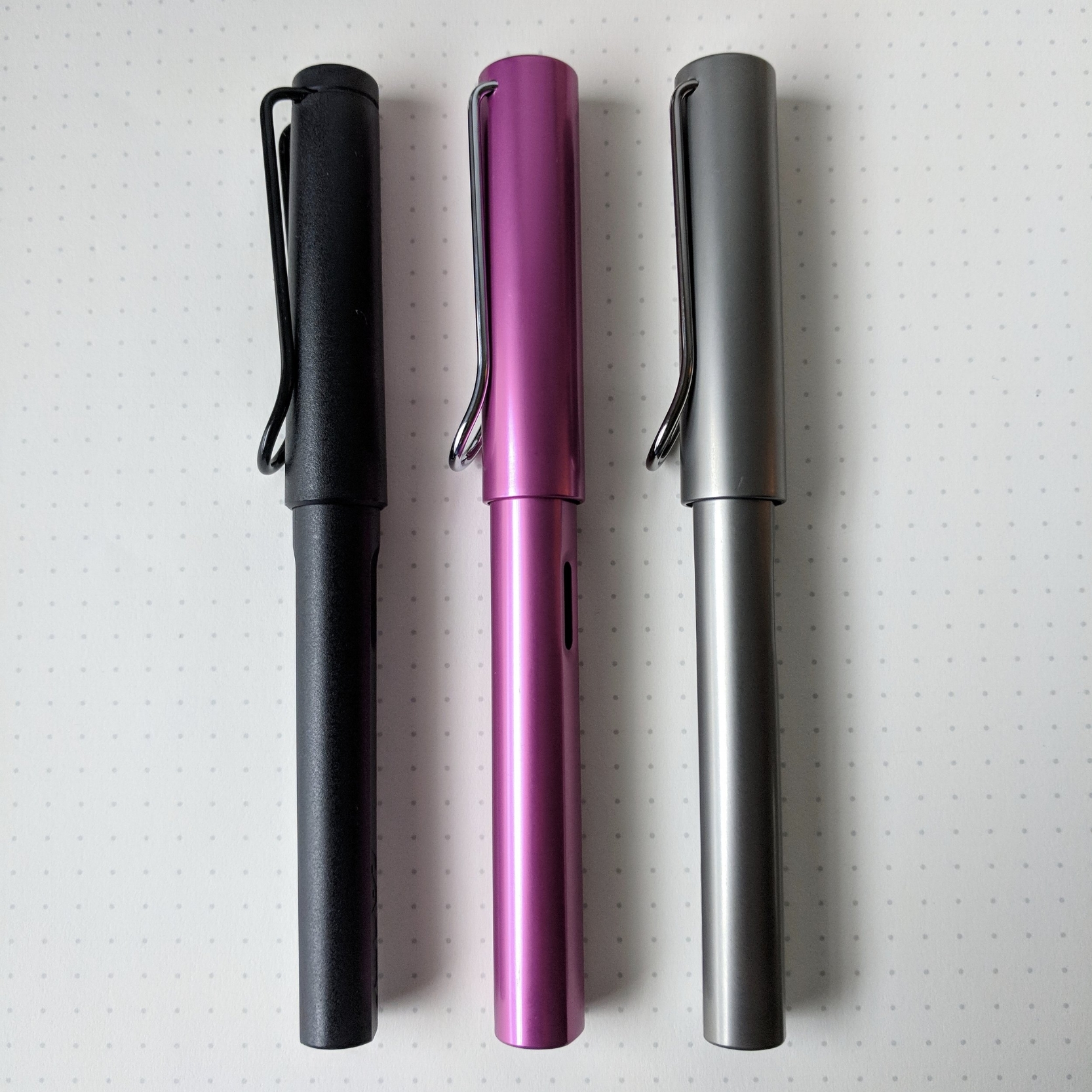The Lamy Safari needs no introduction to readers of this blog. It's a "gateway pen" for a lot of people new to the hobby, and due to its reliability, low price, and overall high quality, tends to stick in the pen case long after many other entry-level pens have been sold off or cast aside in favor of "upgrades." The Safari (along with the slightly pricier AL-Star) also provides a relatively inexpensive way to collect special editions, as Lamy releases a new color of each pen for a limited time each year.
So what makes the Safari a good "Workhorse Pen"?
The Nib. The medium steel nib on the Lamy Safari is a personal favorite, and represents a true bargain at the price point. The ink flow is nearly always consistent, even if I can't see much of a difference between the medium and fine nibs. Lamy also sells inexpensive replacement nibs that you can swap in to change nib size, including a 1.1mm stub.
Size. The Safari itself is a nice size, posted or unposted. The plastic construction also makes the pen extremely light, which gives it excellent "shirt-pocketability" or, absent a pocket, the ability to clip the pen to the placket. (The wide, funky looking clip is highly functional for this purpose - the pen stays put.)
Value Proposition. The Lamy Safari is a great pen that can be found at $30 or less. Given how nice this black-on-black color combination looks, I really wish that Lamy would make the matte black (as opposed to the current "shiny black") part of the regular line.
Availability. Any specialty pen store will typically sell the Lamy Safari. Recently, Lamy has made a major marketing push that appears to be geared towards bringing its pens into mainstream consumer channels. This includes opening Lamy boutiques in cities around the world, including NYC, and placing retail displays in Barnes & Noble.
A trio of Lamy stainless steel nibs, from left: the Lamy Safari All-Black plated nib; the Lamy LX nib, and the Lamy AL-Star nib. The medium nib on the Lamy LX definitely seems wider.
The biggest potential drawbacks to the Lamy Safari as a daily workhorse are the nontraditional design (i.e., if you work in a stuffier office environment) and the triangular grip section. As to the latter, depending on how you grip your pen, you'll either be able to use it or you won't. I also wish that Lamy would include a converter, rather than a single cartridge of Lamy Blue ink, with the Safari, as many other companies like Pilot manage to do so with their entry level pens that start at even lower price points. My previous review of the Safari from a few years back addresses these issues in a bit more depth.
The pen pictured in today's review is this year's special edition Safari, the "All Black." Lamy took some flack this year for going with an "All Black" special edition, especially where they already have a "Charcoal" dark gray model in their regular lineup. I was a bit puzzled myself at the initial announcement, but now that I've had the opportunity to compare the two pens directly, I can confirm that there is a difference. Sure, it's not pronounced, but it's there.
The Lamy Safari Umber (from the standard lineup) is on the left, and the Lamy Safari All-Black, this year's special edition, is on the right.
As an aside, I'm not sure why pen companies decided to double down on the black pen/black trim theme this year, but I assume it's because this color combination has been selling really well. Black pens offer an understated look preferred by many professionals, myself included. In addition to the Lamy Safari All Black, I've recently reviewed the Aurora Talentum "Black Ops" and the Sailor Reglus "Night Black."
A comparison shot of a few similar models of Lamy pens, from left: Lamy Safari All-Black special edition; Lamy AL-Star Vibrant Pink special edition; and the Lamy LX "Ruthenium."
Takeaways and Where to Buy
I received the pen featured in this review from site Pen Chalet. Pen Chalet carries a wide range of Lamy fountain pens, including the Safari. Currently, they still have the All Black special edition in stock, but eventually they will sell out and Lamy will not make any more, so if you'd like to add one of these to your rotation, pick one up. As I mentioned above, if you don't manage to snag an All-Black, the standard edition "Charcoal" color is a close match, but not exact.
Disclaimer: I was not paid or compensated for the content of this review, and all opinions here are my own.
Further Reading
This post is part of a series titled "Workhorse Pens," where I look at those writing instruments that I use most often for everyday writing. Past entries in this series include the Montblanc 146, the Lamy 2000, and the Faber-Castell E-Motion Pure Black.


